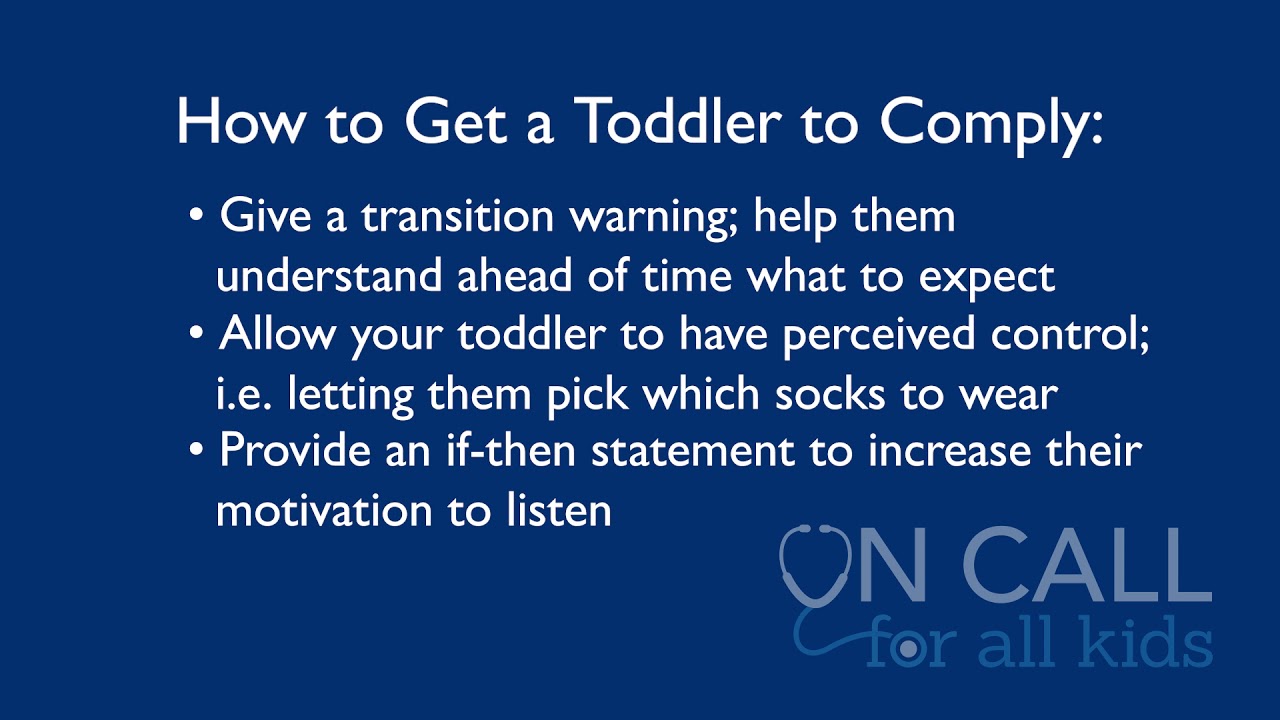How to Get a Toddler to Listen
Featured Expert
How does toddler cognitive development play a role in testing boundaries and not listening? On this week’s On Call for All Kids, Alyssa Fritz, Ph.D., a pediatric psychologist in the Johns Hopkins All Children’s Institute for Brain Protection Sciences, helps parents understand about toddler listening abilities.
Children are going through multiple stages of cognitive change as they continue to develop. As children reach toddlerhood/preschool age, they are looking to gain more autonomy, more independence, and find more times in which they can express this need for independence. Parents often see this expressed as toddlers trying to “control” the situation they are in. This may look like refusal, limit testing, and oppositionality, but for many children, is part of the course of typical cognitive development for toddlerhood. This is a great time to help children develop these skills, while also ensuring they are complying with what we need them to do!
How much should I be expecting my toddler to do at this time? How many commands/requests can a child follow?
From ages 2-3, children should be able to follow at least one direction at a time. As typically developing children advance in age, you can incorporate more directions, up until about three tasks at once, at the most. For now, in these early years, the focus should be on starting with one command or request at a time, and building as your child is experiencing more and more success.
Providing one-step directions means more opportunities for praises for compliance and listening. Examples can include, “thank you so much for listening,” “it makes me so happy that you’re picking up your blocks.” While this communication style is different from how we speak with peers, it is great for kids to know that you’re paying more positive attention to their behaviors.
What are some keys to success to get your toddler to comply?
There are a few keys to success when asking children to do things. We are going to cover a few of these briefly.
A key consideration is providing transitional warnings. Especially when playing, or when transitioning from a preferred task to a less preferred task, make sure to give a warning or two. This looks like “you have five more minutes to play” or “in three more minutes, we will clean up because it is dinner time.” This is a great opportunity for a visual timer too. Transition warnings allow children the opportunity to wrap up their activity and understand that change is coming. These are useful for all children, but can be particularly valuable for children who struggle with transitions.
A second is giving perceived control by providing choices. We know our kids need to get dressed in the morning, but allow them choices in clothing, choices in socks, shoes, everything, as long as it is within reason. Same thing with snacks, toys, etc. Anytime we can give “perceived control” where we are providing a choice, take advantage of that.
The third is if-then statements, and understanding logical consequences.
What is an if-then statement? How do we use this appropriately with toddlers?
Toddlers have to understand language above the 2-year-old level to really have success with this. In addition, as parents, as we talk through if-then statements, you have to make sure you are always willing to follow through with what you say you are going to do. So, an if-then statement is really a “if you do this, then you can do/have that…” For kids, we want to make these statements positive, if you do this … then you can get that. It doesn’t have to be something tangible like a toy, really, we want to tie this to something they can have choice or control over.
Some examples are “if you clean up now, you can choose the show we watch when we get downstairs” or “if you get out of the bathtub now, we can read an extra book before bed.” This can also be earning something, such as more screen time, but that takes us down a different path. Sometimes we do need to take something away, and you have to be prepared to do that. “If you continue to throw the Legos, then I’m taking them out of the room.”
If-then statements capitalize on existing choices and privileges by making access to motivating privileges dependent on their behavior choices. The key here is being consistent. Follow through when you say you are going to do something, or take something away, you have to be prepared to follow through every time, no matter what. Ignoring the tantrum that may follow, and praising compliance, are also keys to success.
You mentioned praise. What is the best way to give praise?
Specific praise is key, and praising the behavior, not the characteristic, is also key. We want to make sure that we are using a positive adjective plus describing the behavior we are praising. “Thank you so much for cleaning up, I really appreciate when you listen and how hard you worked.” Something that we want to focus on is the behavior we are praising, and making sure we aren’t saying something negative at the end, like “I wish you would do that every time,” because that erases everything you just said.







